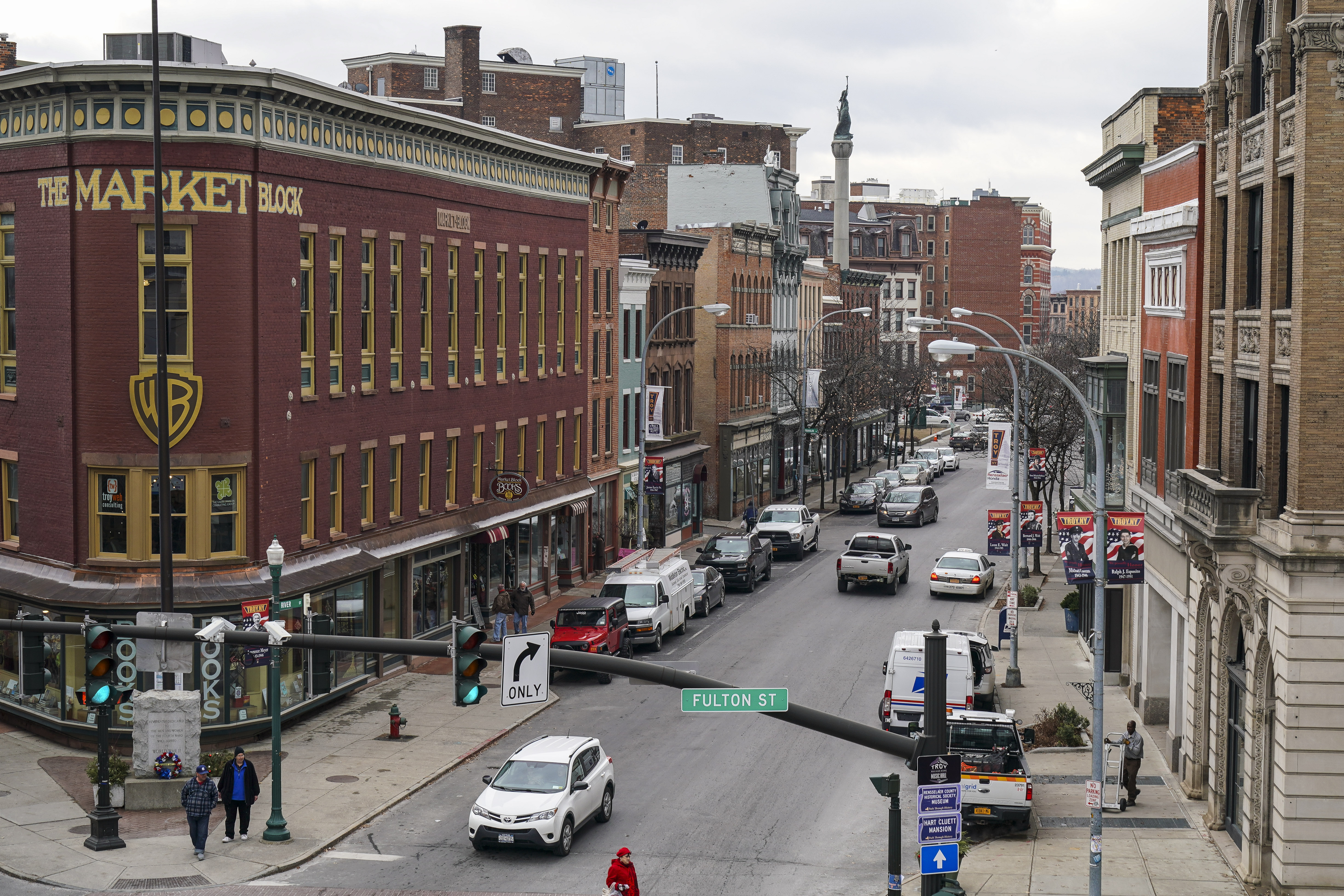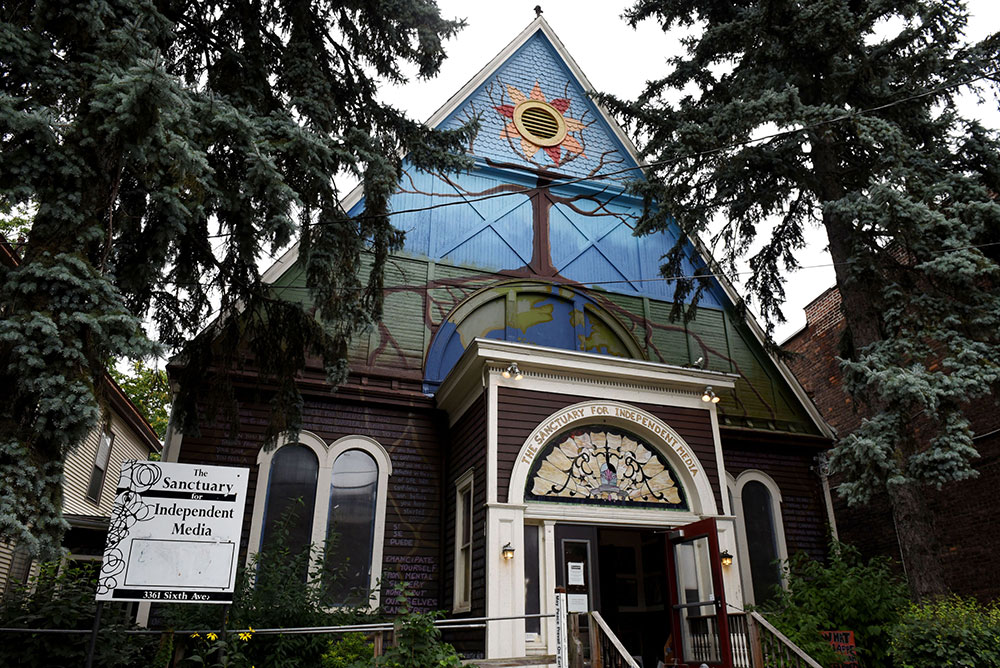
A view of downtown Troy, New York, where the Sanctuary for Independent Media serves the city of about 50,000 with a low-power FM hyperlocal news show, “Hudson Mohawk Magazine”
While podcasts and smart speakers generate buzz, radio—AM/FM, over-the-air, old-fashioned radio—reaches more Americans than any other medium. And technological and regulatory change is still pushing the medium in new directions, one of which is low-power FM.
Low-power FM (LPFM)—a type of non-commercial broadcasting that reaches a very small area—was first granted legal status in the U.S. less than 20 years ago, though unlicensed “pirate” stations existed well before then. Because the signal usually can only be picked up within a few miles of its point of origin, many of these LPFM stations broadcast to concentrated communities, such as farmworkers or neighborhoods of immigrants, and they’ll play announcements or music that might not otherwise be easily found or distributed. “Some of its limitations are some of its strengths,” says Pete Tridish with the Center for International Media Action, a nonprofit that aids in setting up low-power FM stations.
In Troy, a city of about 50,000, 150 miles north of New York City, the Sanctuary for Independent Mediaserves its 10-mile broadcast radius with a hyperlocal news show: “Hudson Mohawk Magazine,” an hour-long program assembled by a team of about 25 volunteers. The large volunteer staff and the limited range of the signal means producers can put out stories with an intense local focus that wouldn’t fit in media with a wider audience. One day in mid-February, for example, a volunteer was editing a piece about the public comments from a city council meeting after one member of the council was revealed to have used racist language in a voicemail. The story was being covered in the local press, but the piece on the “Hudson Mohawk Magazine” would be “people of color in this community talking very knowledgeably and strategically about the entrenched problems of racism here,” says Steve Pierce, executive director of Media Alliance, which owns and operates the Sanctuary.

The Sanctuary for Independent Media in Troy, New York
“There’s no other thing like that,” he says. “Nobody is doing a 10- or 15-minute-long piece of people speaking in their own voice about the problems of the day. The newspaper does a fine job of covering issues, but it’s not in the voice of the people who are living it. And the commercial media are not in a position to do stuff that’s more than a minute or so long, if they do it at all. And the noncommercial stations are focused on the state capitol and not on the neighborhood.”
With newspapers cutting staff or closing entirely, news deserts have been spreading across the U.S. While Troy, with its proximity to the nearby state capital Albany, isn’t a desert, it’s also not awash in local coverage. The local paper has seen cuts, and other outlets, like the local public radio station, serve a wider, regional audience.
Pierce worked in news radio prior to joining the Media Alliance. But his inspiration for the show, he says, came from—of all places—a local Facebook page: “It’s hundreds of people on Facebook who share points of view on what’s happening in the city, many of which I don’t agree with it at all. But it’s fascinating to see that those points of view exist. And it’s important to know they exist.” Pierce wanted to create a place like that on the airwaves—where people go to learn what happened in their community.
Because the Sanctuary is focused on social and environmental justice, the stories tend to cover marginalized groups and labor issues more than traditional media. And because the staff is all volunteers, the production isn’t always as pristine as it might be on a larger station staffed with professional producers and reporters. “It’s a lift. It’s an experiment,” says Elizabeth Press, a Sanctuary board member who also helps put the show together. “But I think it’s a big question when the resources for legacy media are tight and there’s less and less local papers: how do we share information to keep our community engaged in what’s going on and create a population that cares about our town, our place?”
Some volunteers are in their 20s, some in their 70s. And all are responsible for getting segments together for the show. “Hudson Mohawk Magazine” airs every weekday evening at 6, and again the next morning at 7 and 9—hours when locals are commuting and more likely to be in their cars and near a radio. The station doesn’t pay to get official ratings, so nobody knows how many people listen. The anecdotal evidence—contributions, calls, comments in the community—suggests people hear the show. The station also streams live to the internet and posts segments online for anyone to find.
This model could soon spread to other cities. Pierce is working with two LPFM stations elsewhere in upstate New York, and he plans to create a small network. He imagines the other stations will broadcast hyperlocal news to their communities and share stories of wider interest for others to broadcast. It’s the NPR structure, writ small. If the“Hudson Mohawk Magazine” model can be replicated, it could mean more news coverage in more communities.
“There’s hope,” Pierce says. “The situation for journalism and media—media in general, journalism in particular—it’s just very depressing right now. So for people to be able to put their hands on the problem and try to make a difference, however small it may be, that’s a huge thing.”
